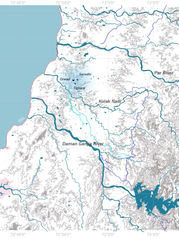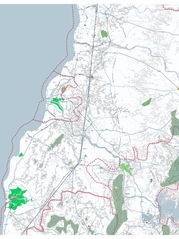Akanksha Thakur
A20-41
School of Environment and Architecture
Faculty: Rhea Shah
COURSE BRIEF

READINGS
1. LOOKING BACK AT LANDSCAPE URBANISM
.png)
The author Julia Czerniak imagines landscape as a particular culture of and consciousness about the land that refrains from the superficial reference to sustainability,ecology,and the complex processes of our environments in favor of projects that actually engage them.
According to architect James Corner the nineteenth century notions of public spaces where nature is seen as separate from the city, is imaged as undulating and pastoral and acts as a moral antidote to urbanization.
The following projects are discussed in this book which challenge this notion and attempt to make landscape visible and legible through the everyday life thereby to build new relationships
-
Guadalupe River (1988)
-
Byxbee Parks (1991)
-
Rebstockpark (1992)
-
Plaza Park (1989)
2. IDEAS OF NATURE

When we say about nature do we include ourselves?
The book traces evolution of ideas of nature over the years as to how in the medieval age - the age of discovering relationships with man and god, the concept of nature was god's creation. The conventional idea of nature is understood as being untouched, not spoilt, separated from man. 18th century this idea of nature shifts to order and right reason as the societal structure itself held administrative power. In early 19th century the idea of nature evolved as countryside retreats. in the second half of 19th century nature was seen as savage and cruel. The book concludes as
When nature is separated out from the activities of men, it even ceases to be nature, in any full or effective sense.
We have mixed our labour with earth, our forces with earth’s forces too deeply to be able to draw back and separate either out.
UDVADA SITE VISIT



SARODHI, UDVADA
Sarodhi is a village located at approx 6 km away from Udvada along the national highway 48. The entrance to the village from the highway is marked by two banyan trees on either side of the road which gives the place its name ‘bevad’. The village spreads across an area of 3.58 sq km with a lake of an area of approx 15 acres.The main occupation practiced here is farming. The tribals fish from the lake according to their need. While strolling along the lake with one of the villagers we found that the locals had a good knowledge about the medicinal properties of plants. This intrigued us towards understanding the ecology around the village. We explored how vegetation can be one of the ways to look at a site.

This gif traces the evolution of the lake over the years. The lake has transformed over the years due to the digging that that is done by the villagers to extract the kali mitti from the lake. This results in the increasing depth of the lake. The transition of the lake here shows how the drying pattern of the lake along with the graph of rainfall showing the
Segregation of the lake into parts like the dry path, the vegetation patch and the water patch.
The amount of rainfall received in that year is shown by the graph.

The current drawing shows the changing cover of vegetation around the lake over the seasons. Most of the area around the village is covered by mango and chikoo orchards. These are all grown for commercial purposes. The variety of mangoes is seen in each farm, which are called ‘wadis’. The edges of the lake are covered by several medicinal plants, trees and shrubs. Plants inside the lake are mainly lotus, water lilies, water lettuce and wild grass that change with respect to seasons. The cover represents the overlaps of plants indicating the dependence of growth of one plant on another. For example, some medicinal plants do not require intense amounts of sunlight and thus their growth under the trees with large canopies helps the plants in surviving and drying up. Similarly, Every larger tree has several creepers growing on the trunks keeping probing the barks for insects and spiders.




The following drawings represent mapping of the lake boundaries at specific intervals through transacts from settlements, farmland, etc. which are rich in floral diversity.
Ground Water table rises during rainy season and falls back during summer season due evaporation.
The vegetation changes with the excess growth of IVy creepers in Rainy season creating a blur edge between land and water. Water for farmland is been channeled out from the lake.




This drawing shows the lifecycle of different plants found around the lake.
We started looking at the changing lake conditions according to the seasons. Two major types of fishes found here are rohu and catla. There are majorly three types of plants found in lake - lily, lotus, water lettuce


In monsoon one can see a dense patch of vegetation around the lake with rich diversity within the plants. Water level is maximum but the lake water does not flood into the locality


With the mark of fall between october and november leaves of lilies and lotus wither and dry off while the quantity of water lettuce reduces. Seeds in small flowers ripen and eventually disperse into the water.


During winter from december to february as the temperature goes down, the plants stop flowering and lay dormant


As the spring season starts with february, one can see blossoms of lettuce and lilies. Lotus grows vigorously during this season.


In summer, as the water level is at the lowest and the temperature conditions are favourable we see a larger part of the lake covered with blossoms of all three species.
Inference -
This plant cover is good as it helps to block sunlight and keep the temperature of a pond low in the summertime and it also helps to maintain the ecosystem of the pond by preventing too much algae growth . However there are chances that the thick growth of plants in lakes will increase evaporation and transpiration of the water and dry up the ponds. Also if these species overgrow it can be difficult to control and will take over other plant species in the ecosystem. While studying about the life cycles of these plants it was found that water liles and lotuses have their roots buried into the ground at a specific depths of about 6 ft. Whereas water lettuce detaches itself from its parent plant after being mature. In the current scenario the lake have a gentle slope throughout the periphery so there are always lilies and lotus growing. This then creates inaccessibility as boats cannot be taken into the lake because while rowing the oars will get entangled into stems of these plants. So if we modulate the edge at some places to create steep slopes then lilies and lotus will not grow over there and also lake will be more accessible to people. Among the fishes currently found in the lake rohu fish feeds on aquatic plants so that can control the number of water lettuce .
.png)
.png)









